Combat aircraft. Uralbomber from a different perspective
If you open the materials on the Griffin on the Internet, in 9,5 cases out of 10 we can read something similar to the quote from Nekrasov’s poem that “This groan is called a song in our country ...” Such a mournful sobbing about “ Luftwaffe lighter ”was about nothing, a plane rubbish, one sheer miscalculation of Goering, Hitler, Heinkel, Milch, in short, all.
And where to him before Pe-8, in general it is not clear.
However, here is a suggestion. Let's just look at the plane. On a distant bomber, which, I note, was made in the amount of more than a thousand copies. And there, perhaps, we will draw some conclusions about failure and incompetence.
Let's start almost fabulously: there was a general. This sometimes happens, and the generals are different, and smart, and not very. Our general was smart. His name was Walter Wefer, he had the rank of lieutenant general and served as chief of staff of the Luftwaffe.
And planning all kinds of plans, Wefer thought about the need for the Luftwaffe to have a long-range bomber capable of achieving goals at the most distant points. For example, the main naval bases of Great Britain or steel mills of the Soviet Urals. Yes, the Germans were aware of the development of metallurgy in the Urals and even then thought that these centers would need to be affected.
Work in this direction has been carried out since 1935, and in general began to think about a long-range bomber in the Luftwaffe in 1934.
The first experiments did not work out very well. The Do.19 and Junkers Ju.90 created as part of the Dornier project did not impress the Luftwaffe leadership, and by 1937 the work on them had been curtailed, and all prototypes made were used as transport aircraft.
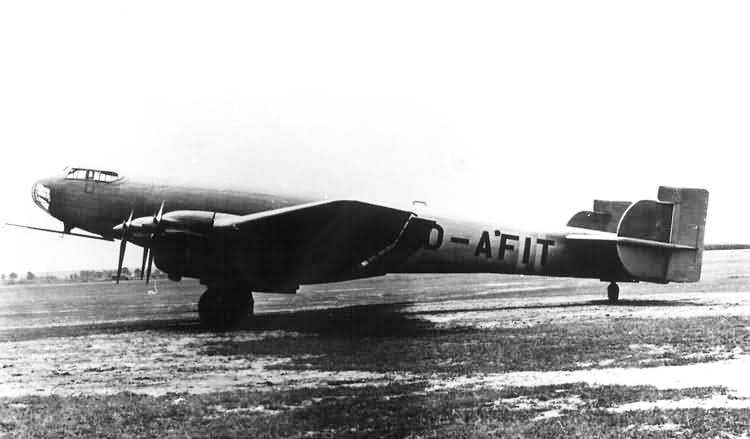
Junkers Ju. 89
In 1936, the technical department of the ministry aviation introduced new requirements for the long-range medium bomber. Flight range 5000 km, bomb load 500 kg, crew: pilot, navigator and shooter-operator of remotely controlled shooting installations.
The requirements were sent to Blom und Foss, Heinkel, Henschel, Junkers and Messerschmitt. It is not known for certain who and how started working on the project (if at all started), but in 1936, Wefer died in a plane crash, and the uralbomber program seemed to be terminated.
“It seems to be,” although for the vast majority this was the collapse of the entire Luftwaffe long-range bomber aviation, but just a month later, Heinkel’s company received an order for the aircraft under the 1041 project.
Everything is simple. One program was discontinued, another started. Obviously, only Heinkel’s work went at least in approximately the direction that the ministry determined.
November 5, 1937 "project 1041" received the official designation He.177, and began story this plane. Full of ambiguities and misunderstandings.
The Ministry of Aviation seriously planned that Heinkel would bring the plane to normal in a couple of years, and in the late 1940 - early 1941 the Luftwaffe would have a long-range bomber, with which you can start kneeling the UK.
However, the ministry itself, with the full support of the Luftwaffe, began to engage in outright foolishness: the range of the bomber was supposed to grow to 6500 km, the bomb load to 1000 kg, the maximum speed should be 535 km / h.
Well and the main thing: the plane had to be able to bomb from a dive. Let a gentle, but dive. In those days, many tried to do something like this, but not everyone could dive.
Further, it was necessary to increase the wing area, the ammunition for machine guns up to 6000 rounds, to put more powerful radio equipment. The crew also increased - up to 4 people.
The designer of the “Project 1041” Siegfried Gunther was faced with a difficult choice. In general, the problem was simple: in Germany there were no engines capable of satisfying the set requirements. And Gunter did a local miracle by placing a pair of DB601 engines in the design, which was designated DB606. In the DB 606 engine, two 12-cylinder V-shaped units based on the DB 601 were mounted side by side and worked on a common shaft through a gearbox connecting both crankshafts.
The take-off weight of the He.177 with DB606 was estimated at 25 tons, and the speed of 500 km / h at an altitude of 6000 m was greater than that of many of the fighters of that time.
However, problems began. The main problem was the new chief of staff of the Luftwaffe, Major General Joshonnek, who was inclined to believe that Germany should pay attention to medium-sized bombers, based on the successful experience of using twin-engine bombers in Spain. If it were not for Kriegsmarine’s application for a long-range reconnaissance aircraft for interaction with submarines, most likely, He.177 would never have been born.
With great difficulty, permission was obtained for a preliminary series of six aircraft and a plan was approved for the construction of six more aircraft with four BMW 801 engines, if it is not possible to arrange the operation of twin engines from Daimler-Benz.
The installation of four motors eliminated diving, so Heinkel concentrated on debugging the DB 606. At the same time, it was decided to introduce a rather impressive number of technical innovations to the design in order to maximize the interest of potential customers from the Luftwaffe and Kriegsmarine.
Such an innovation was the use of remotely controlled rifle installations, which had significantly less aerodynamic drag than turrets with shooters. In the construction of He.177, a boom-operator cabin was made, which controlled three units from it. It was noted that the pickup angles and the response speed of the installations are "approaching ideal." That was in August 1939.
However, the Luftwaffe continued the show with new requirements for the aircraft. Firstly, they demanded that the remote-controlled installations be replaced by conventional manual ones. For reliability. Secondly, the dive angle was required to be increased to 60 degrees. I had to strengthen the design and modify the landing gear, since all this led to an increase in the mass of the aircraft.
While the Luftwaffe and the Ministry of Aviation were playing with the Heinkel project, 1939 struck. The Second World War has begun. And it was followed by the Battle of Britain, which the Germans successfully lost, not least because of the insufficient range of their Do.17, He.111 and Ju.88.
Perhaps, anticipating a shortage of range from their bombers, the Luftwaffe demanded that Heinkel speed up the work, and on July 6, 1939 an order was placed for 20 He.177A-0. Subsequently, the order was increased to 30 cars. The first flight of Ne.177 took place on November 19, 1939, ended prematurely and indicated a bunch of flaws in the aircraft.
On the other hand, there was a good confident take-off, landing and handling.
During the tests, the weight of the empty He.177 V1 was 13 730 kg, take-off weight - 23 950 kg. The maximum speed was 460 km / h, as much as 80 km / h less than the specified. The cruising speed was also lower, 410 km / h, and the maximum flight range was calculated at 4 km - 970% less than the specified one.
And this despite the fact that a completely defensive weapon was not installed.
"Gave the heat" in the truest sense of the word and engines. Gasoline and oil wires flowed and caused fires, oil overheated, engines did not treat oil starvation very well.
The first production Ne.177A-0 flew in November 1941. These machines differed from the prototypes in the cockpit and a modified tail unit.
The crew increased to five people. The maximum bomb load was 2400 kg. Defensive armament consisted of one 7,9-mm MG.81 machine gun in the bow mount, a 20-mm MG-FF gun in the nose in the lower gondola, a pair of MG.81 machine guns in the tail of the gondola, and two 13-mm MG.131 machine guns in the upper tower and tail installation.
The first five He.177A-0 were used for diving tests, during which a speed of 710 km / h was achieved. This required equipping at least one aircraft with lattice brakes, although in reality the He.177 was not able to safely exit the dive even with a moderate angle. Unfortunately, this was achieved as a result of several disasters. Plus, tests revealed yet another unpleasant phenomenon: constant structural vibrations at speeds above 500 km / h. The result was a limitation of flight speed with this particular number.
Yes, Ne.177 was still considered a dangerous and not very reliable aircraft due to engine problems, but experienced pilots from the specially designed test squadron 177 received the bomber well. Still, the Ne-177 was pleasant to fly and flew pretty well. And the flight duration, which was so interesting for Kriegsmarine, gradually reached 12 hours.
It was assumed that, in addition to conventional bombs, He.177 could carry both Fritz-X and Hs.293 guided bombs, as well as depth charges.
In early January 1943, Hitler personally touched on the work on He.177, familiarizing himself with a pile of documents and reports. He was very interested in exactly the plane, which could solve the problem of attacks on the distant rear enterprises of the Soviet Union. The Führer issued subordinates from the Ministry of Aviation both for failure to meet deadlines, and for being distracted by frankly stupid ideas such as creating a dive four-engine bomber. The DB606 also got - not as reliable as we would like and difficult to operate.
But even Hitler’s timely intervention didn’t help much, and in the middle of October 1942 the 130th and last He.177A-1 left the assembly line in Warnemunde. But at the same time, in Oranienburg, the production of an improved version of He 177A-3 was in full swing. The main difference was an engine mount extended by 20 cm and an additional 1,6 m section in the fuselage behind the bomb bay. An additional upper turret was installed behind the wing with a pair of 13 mm MG.131 machine guns with 750 rounds per barrel.
It was decided to equip the He.177A-3 with more powerful engines. But it did not work out, the new engines could not be debugged, so the new plane went into series with the old engines. The Ministry of Aviation set the pace of production of 70 cars per month, but due to constant improvements by the beginning of 1943, the output was only five (!) Cars per month.
At the beginning of winter 1942-1943 Ne.177 were urgently thrown to supply the German troops encircled in Stalingrad as transport aircraft. Here the following happened: in the maintenance parts on several machines, a 50-mm VK 5 gun was placed in the lower gondola. The ammunition for the gun was located in the bomb bay. They tried to use these field modifications to attack ground targets.
It turned out so-so. The horizontal bomber was completely unsuitable for such a thing as an attack.
However, He.177A-3 / R5 or the Stalingradtip with a 75-mm VK-7.5 cannon in the lower gondola was still created. They planned to use these machines as naval scouts instead of the rapidly aging Condor Fw.200. It was assumed that powerful offensive weapons would allow to hit both ships and transport aircraft over the Atlantic.
Like the attack tanks near Stalingrad, the idea of sinking ships was also difficult to implement.
By 1943, when the Allies finally complicated the life of the German submariners, Grand Admiral Doenitz began to insist especially on the support of submarines by torpedo bombers made on the basis of He.177.
As a result, the 26th bomber squadron appeared, which was armed with the He.177A-3 / R7. Torpedoes did not fit into the bomb bay, so they were simply hung under the fuselage. The plane quite normally carried two standard L5 torpedoes.
But it all ended in October 1944, when an urgent order came to terminate all work in connection with the adoption of the "urgent extermination program." On the assembly line, He.177 was replaced by Do.335, ironically, also a plane with a tandem engine layout.
Large-scale production of the He.177 aircraft ended on version A-5, and further modifications did not go beyond the prototype stage.
Meanwhile, the following model, He.177A-6 was developed taking into account the wishes of front-line pilots. And it was already a very interesting car.
A-6 gas tanks were armored, a four-machine gun remotely controlled Rheinmetall turret appeared in the tail of the aircraft, which possessed solid firepower.
In addition, the A-6 was equipped with a pressurized cabin and an additional gas tank instead of the front bomb bay. With this tank, the flight range was calculated at 5800 km.
There was a project No.177A-7. It was a high-altitude long-range reconnaissance, preserving the ability to carry a bomb load. The wing span was increased to 36 m, the power plant - two DB613 engines (two twin DB603G, giving off take-off power of 3600 hp each). The mass of the empty aircraft was 18 100 kg, take-off - 34 641 kg. The maximum speed is 545 km / h at an altitude of 6000 m.
Ne.177A-7 was planned to be released by the Japanese, but the outbreak of the war did not present the opportunity to deliver a prototype to Japan.
As a result, it all ended as for many projects of other companies: a complete failure. And the plane was very promising. Its vast compartments made it possible to accommodate a lot of payload. If it came to installing a radar, I’m sure there would be no problem.
Was the plane unsuccessful?
Not sure.
Unsuccessful aircraft do not build more than a thousand cars. In a country like Germany, during the war, many interesting projects played a role in history at the prototype level. And here - 1000+. Doesn't fit.
An interesting twin engine system, an original chassis, remotely controlled shooting systems ...
Another question is that for some reason they wanted to make a heavy bomber dive. A heavy bomber was used as a transport aircraft in the Stalingrad boiler. A heavy bomber weighing 25 tons began to be converted into an attack aircraft with large-caliber guns.
If you look objectively, you understand that for the failures of He.177 the responsibility lay with the Ministry of Aviation, which clearly had a poor idea of what it needed from the plane. And incompetence can not always be compensated.
In fact, there were no particular flaws in the He.177 project, problems were characteristic of all German bombers. Yes, plus more continuous improvements at the request of the Ministry of Aviation. "Children's illnesses" are generally inherent in all new cars, but here the matter is rather different.
The fact is that strategic long-range aviation is a very difficult and expensive business. A heavy aircraft with good performance characteristics, good defense and armament is not so simple. And not every country can handle it - to have a fleet of strategic bombers. This generally only the Americans and the British succeeded.
If Germany had such a budget that could allow it not to delve into He.177 for several years, bringing it to mind, saving on everything, the result could be completely different. But when there is no money, and a rather promising machine serves to plug holes, no ingenious and modern design developments will help.
So, perhaps, hanging on the Ne.177 the label of an unsuccessful aircraft is somewhat unfair. A huge amount of work was done, the Ministry of Aviation and the Luftwaffe, just mired in intrigues, did not give the opportunity to implement the project.
But this is not so bad, after all, is it?
LTX He.177a-5 / r-2
Wingspan, m: 31,40.
Length, m: 22,00.
Height, m: 6,40.
Wing Area, m2: 100,00.
Weight, kg:
- empty aircraft: 16 800;
- normal take-off: 27;
- maximum take-off: 31 000.
Engine: 2 x Daimler-Benz DB-610A-1 / B-1 x 2950 hp
Maximum speed km / h:
- near the ground: 485;
- at height: 510.
Cruising speed, km / h: 415.
Practical range, km: 5.
Practical ceiling, m: 8 000.
Crew, person: 6.
Armament:
- one 7,9-mm machine gun MG-81J with 2000 rounds in the nose;
- one MG-151/20 cannon in front of the lower gondola (300 shells);
- one MG-151/20 cannon in the tail unit (300 shells);
- two 7,9 mm MG-15 machine guns with 2000 rounds in the rear of the gondola;
- two 13-mm machine guns MG-131 in a remotely controlled turret behind the cab;
- one 13-mm MG-131 machine gun in the rear turret with an electric drive with 750 rounds per barrel.
In the bomb bay:
- 16x50kg, or 4x250kg, or 2x500kg or
On external holders:
- 2 LMA-III mines, or 2 LT-50 torpedoes, or 2 Hs.293 or Fritz-X missiles.
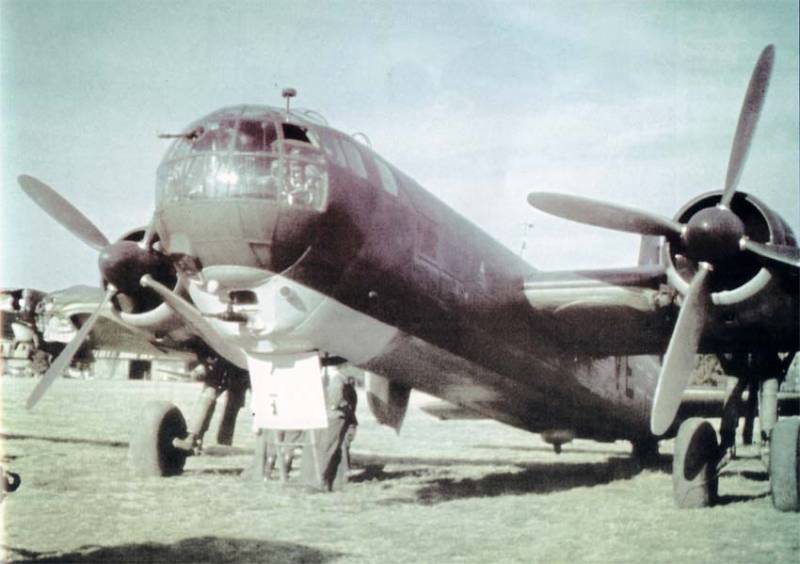
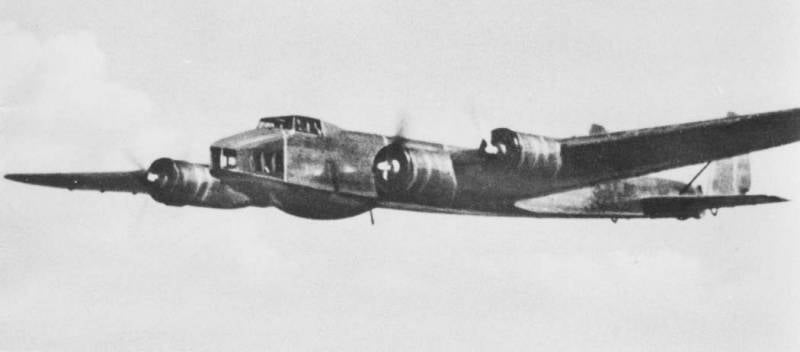
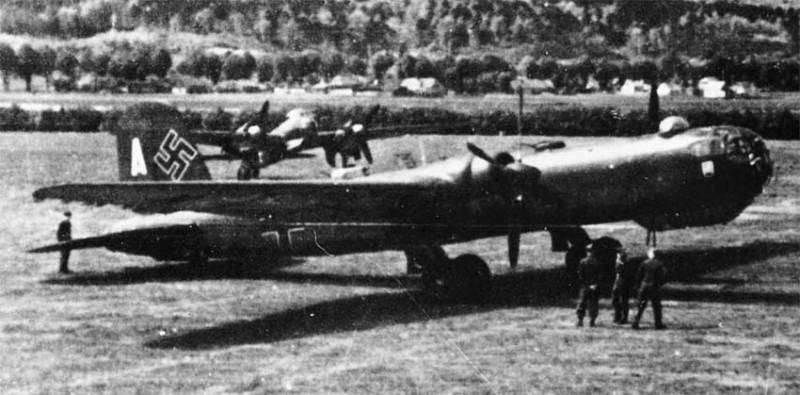
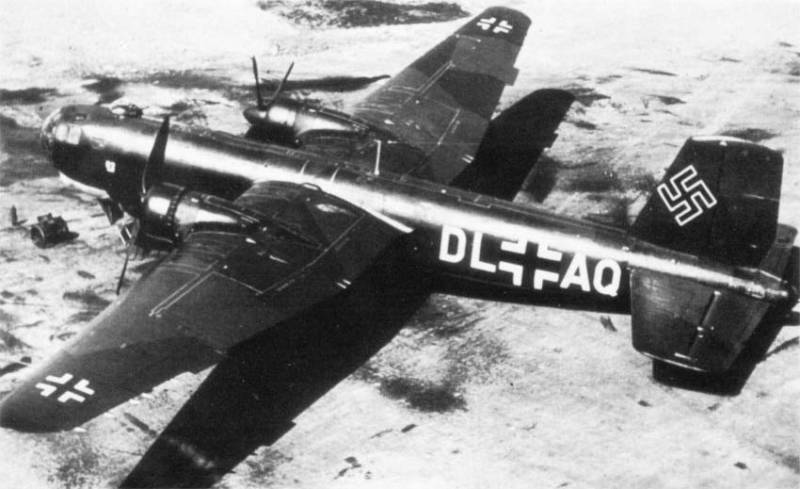
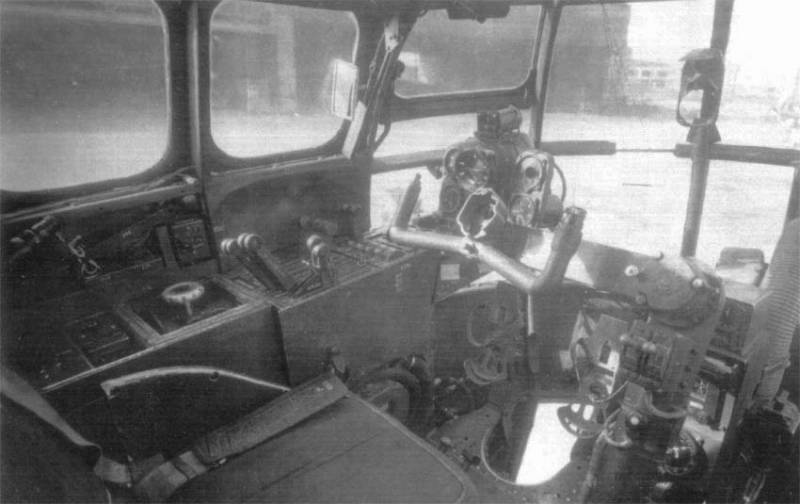
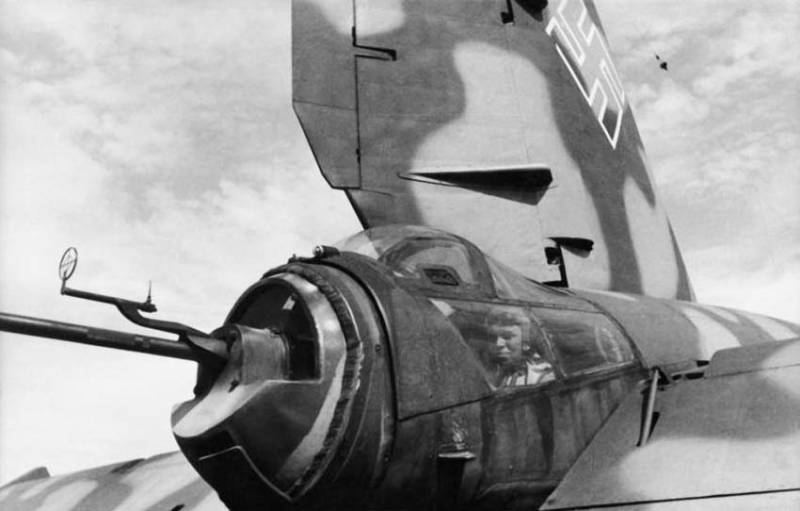
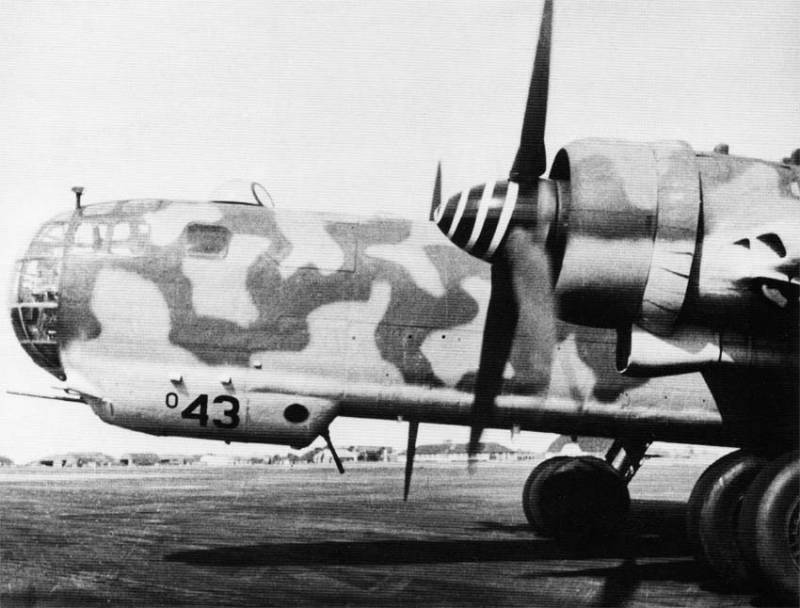
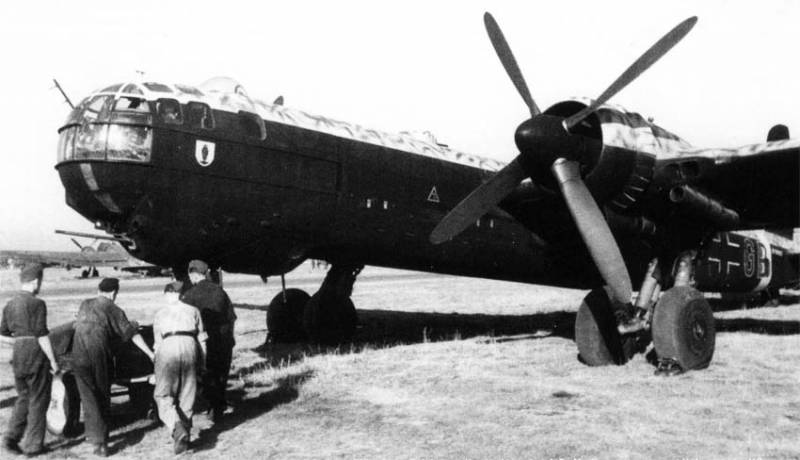
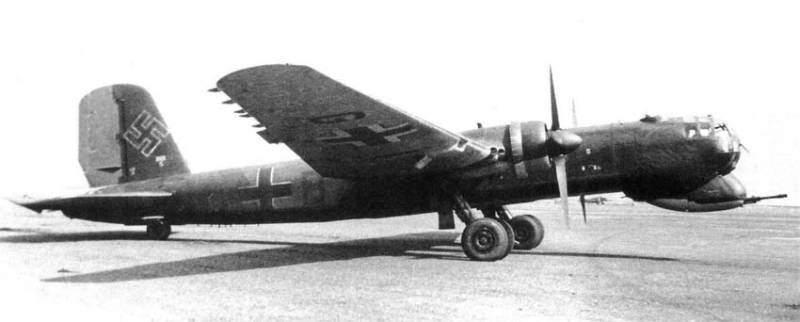
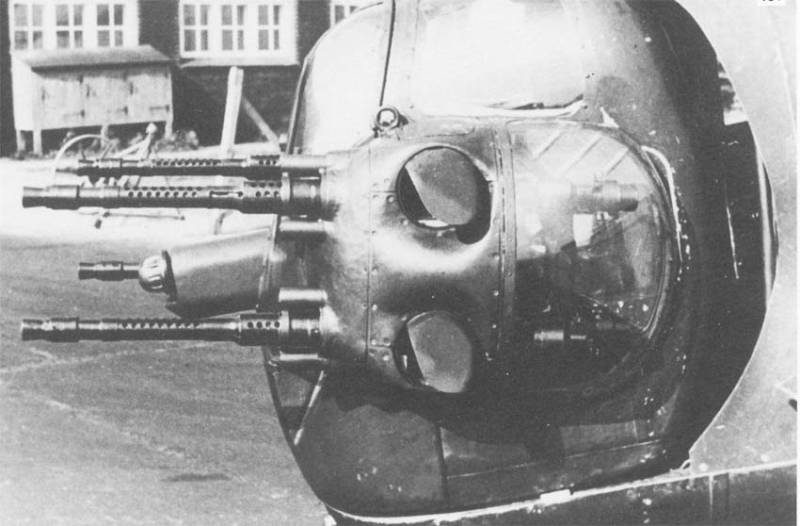
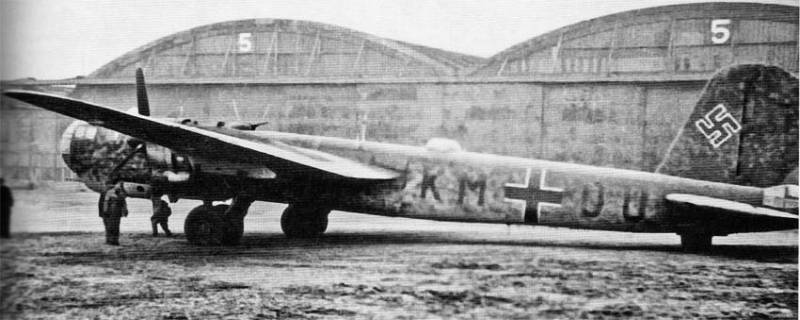
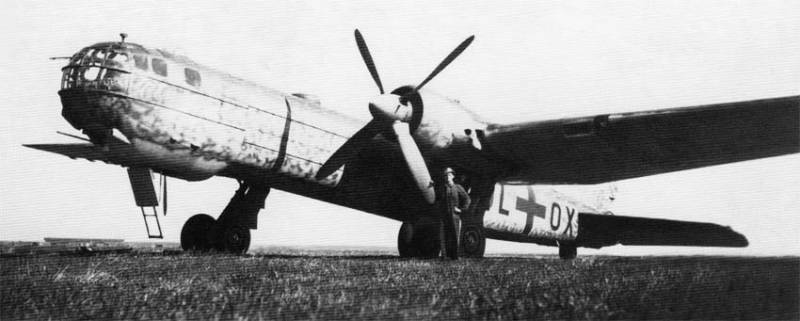
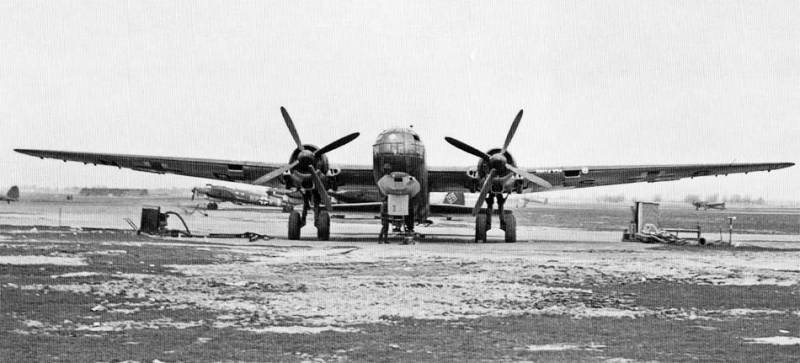
Information